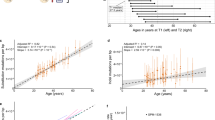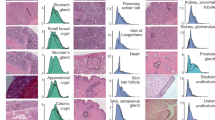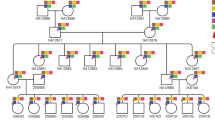Abstract
Trinucleotide repeat mutations of normal alleles at the human androgen receptor locus were studied by typing ∼4,300 sperm. Control experiments established that the mutation events were of germline origin. The mutation rate for 20–22 repeat alleles was similar to that shown by family analysis. Alleles with 28–31 repeats had a 4.4 times greater rate of mutation with contractions outnumbering expansions. Preliminary experiments on the trinucleotide repeat associated with myotonic dystrophy gave similar results although in one donor expansions were six times greater than contractions. Comparison of the sperm data to mutations of disease alleles in SBMA families suggests that expansions may have a different origin than contractions.
This is a preview of subscription content, access via your institution
Access options
Subscribe to this journal
Receive 12 print issues and online access
$259.00 per year
only $21.58 per issue
Buy this article
- Purchase on SpringerLink
- Instant access to full article PDF
Prices may be subject to local taxes which are calculated during checkout
Similar content being viewed by others
References
Caskey, C.T., Pizzuti, A., Fu, Y.-H., Fenwick, R.G. & Nelson, D.L. Triplet repeat mutations in human diseases. Science 256, 784–789 (1992).
Richards, R.I. & Sutherland, G.R. Dynamic mutations: a new class of mutations causing human disease. Cell 70, 709–712 (1992).
La Spada, A.R., Wilson, E.M., Lubahn, D.B., Harding, A.E. & Fischbeck, K.H. Androgen receptor gene mutations in X-linked spinal and bulbar muscular atrophy. Nature 352, 77–79 (1992).
Huntington's Disease Collaborative Research Group, A novel gene containing a trinucleotide repeat that is expanded and unstable on Huntington'sdisease chromosomes. Cell 72, 971–983 (1993).
Orr, H.T. et al. A Expansion of an unstable trinucleotide repeat in spinocerebellar ataxia type 1. Nature Genet. 4, 221–226 (1993).
Miwa, S. Triplet repeats strike again. Nature Genet. 6, 3–4 (1994).
Weber, J.L. & Wong, C. Mutation of human short tandem repeats. Hum. molec. Genet. 2, 1123–1128 (1993).
Donnelly, A. et al. A linkage map of microsatellite markers on the human X chromosome. Genomics 20, 363–370 (1994).
Edwards, A., Hammond, H.A., Li, J. & Caskey, T. Genetic variation at five trimeric and tetrameric tandem repeat loci in four human population groups. Genomics 12, 241–253 (1992).
Weber, J.L. & May, P.E. Abundant class of human DNA polymorphisms which can be typed using the polymerase chain reaction. Am. J. hum. Genet. 44, 388–396 (1989).
Litt, M. & Luty, J.A. A hypervariable microsatellite revealed by in vitro amplification of a dinucleotide repeat within the cardiac muscle actin gene. Am. J. hum. Genet. 44, 397–401 (1989).
Crow, J.F. How much do we know about spontaneous human mutation rates? Environ. molec. Mutagen. 21, 122–129 (1993).
Jansen, G., Coerwinkel-Driessen, M., Nillesen, W., Brunner, H. & Wieringa, B. Dinucleotide repeat polymorphism at locus D19S207, close to the myotonic dystrophy (DM) gene. Hum. molec. Genet. 2, 333 (1993).
Jansen, G. et al. Physical and genetic characterization of the distal segment of the myotonic dystrophy area on 19q. Genomics 13, 509–517 (1992).
La Spada, A.R. et al. Meiotic stability and genotype-phenotype correlation of the trinucleotide repeat in X-linked spinal and bulbar muscular atrophy. Nature Genet. 2, 301–304 (1992).
Biancalana, V. et al. Moderate Instability of the trinucleotide repeat in spino bulbar muscular atrophy. Hum. molec. Genet. 1, 255–258 (1992).
Imbert, G., Kretz, C., Johnson, K. & Mandel, J.L. Origin of the expansion mutation in myotonic dystrophy. Nature Genet. 4, 72–76 (1993).
Neville, C.E., Mahadevan, M.S., Barcelo, J.M. & Korneluk, R.G. High resolution genetic analysis suggests one ancestral predisposing haplotype for the origin of the myotonic dystrophy mutation. Hum. molec. Genet. 3, 45–51 (1994).
Cui, X. et al. Single-sperm typing: Determination of genetic distance between the Gγ-globin and parathyroid loci by using the polymerase chain reaction and allele-specific oligomers. Proc. natn. Acad. Sci. U.S.A. 86, 9389–9393 (1989).
Li, H., Cui, X. & Arnheim, N. Analysis of DNA sequence variation in single cells. In Methods-A Companion to Methods in Enzymology. Vol. 2, 49–59 (Academic, New York, 1991).
Hubert, R., Weber, J.L., Schmitt, K., Zhang, L. & Arnheim, N. A new source of polymorphic DNA markers for sperm typing: analysis of microsatellite repeats in single cells. Am. J. hum. Genet. 51, 985–991 (1992).
Lupski, J.R. et al. DNA duplication associated with Charcot-Marie-Tooth Neuropathy type 1A. Cell 66, 218–232 (1991).
Author information
Authors and Affiliations
Rights and permissions
About this article
Cite this article
Zhang, L., Leeflang, E., Yu, J. et al. Studying human mutations by sperm typing: instability of CAG trinucleotide repeats in the human androgen receptor gene. Nat Genet 7, 531–535 (1994). https://doi.org/10.1038/ng0894-531
Received:
Accepted:
Issue date:
DOI: https://doi.org/10.1038/ng0894-531
This article is cited by
-
Novel approach for deriving genome wide SNP analysis data from archived blood spots
BMC Research Notes (2012)
-
Determining microsatellite genotyping reliability and mutation detection ability: an approach using small-pool PCR from sperm DNA
Molecular Genetics and Genomics (2011)
-
Features of trinucleotide repeat instability in vivo
Cell Research (2008)
-
Single-cell analysis of unstable genes
Journal of Assisted Reproduction and Genetics (1996)



